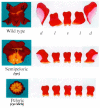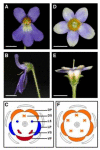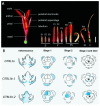Advances in Research on the Regulation of Floral Development by CYC-like Genes
- PMID: 36975501
- PMCID: PMC10047570
- DOI: 10.3390/cimb45030131
Advances in Research on the Regulation of Floral Development by CYC-like Genes
Abstract
CYCLOIDEA (CYC)-like genes belong to the TCP transcription factor family and play important roles associated with flower development. The CYC-like genes in the CYC1, CYC2, and CYC3 clades resulted from gene duplication events. The CYC2 clade includes the largest number of members that are crucial regulators of floral symmetry. To date, studies on CYC-like genes have mainly focused on plants with actinomorphic and zygomorphic flowers, including Fabaceae, Asteraceae, Scrophulariaceae, and Gesneriaceae species and the effects of CYC-like gene duplication events and diverse spatiotemporal expression patterns on flower development. The CYC-like genes generally affect petal morphological characteristics and stamen development, as well as stem and leaf growth, flower differentiation and development, and branching in most angiosperms. As the relevant research scope has expanded, studies have increasingly focused on the molecular mechanisms regulating CYC-like genes with different functions related to flower development and the phylogenetic relationships among these genes. We summarize the status of research on the CYC-like genes in angiosperms, such as the limited research conducted on CYC1 and CYC3 clade members, the necessity to functionally characterize the CYC-like genes in more plant groups, the need for investigation of the regulatory elements upstream of CYC-like genes, and exploration of the phylogenetic relationships and expression of CYC-like genes with new techniques and methods. This review provides theoretical guidance and ideas for future research on CYC-like genes.
Keywords: CYC2 clade; CYCLOIDEA (CYC)-like gene; TCP gene family; floral symmetry; molecular regulatory mechanism; phylogeny.
Conflict of interest statement
The authors declare that the research was conducted in the absence of any commercial or financial relationships that could be construed as potential conflicts of interest.
Figures








References
Publication types
Grants and funding
LinkOut - more resources
Full Text Sources
Research Materials
Miscellaneous

